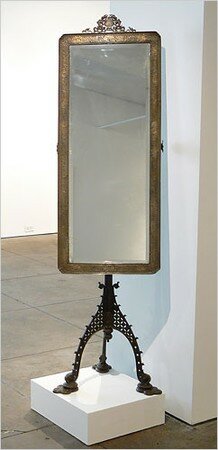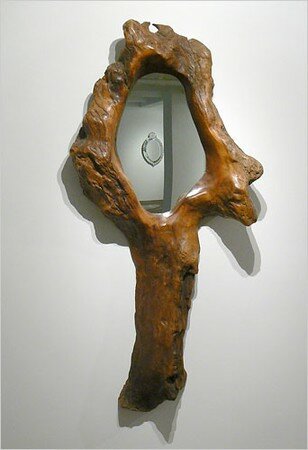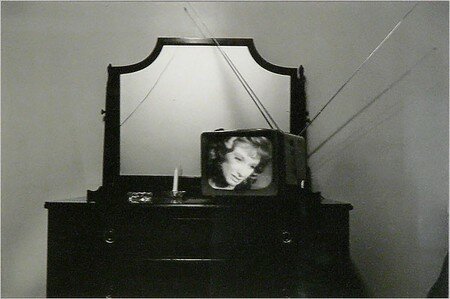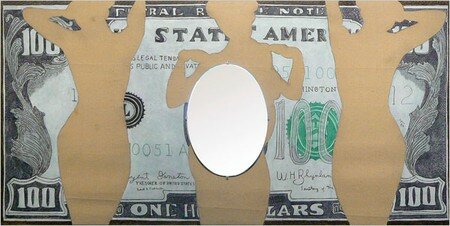"Miroir, miroir, suis-je ..."
Stand before a mirror. What do you see? Yourself? Another room? A portal to an alternate world? A domestic accouterment? A symbol of vanity? A sheet of glass with a metallic coating applied to its back side?
"Mirror Mirror," a philosophically diverting exhibition of old mirrors and artworks related to mirrors at Edward Thorp Gallery in Chelsea, offers no systematic theory of what mirrors mean to us, but it does give pause for rumination.
An 18th-century Italian mirror. (Photo: Edward Thorp Gallery)
Decorative-arts connoisseurs will appreciate the 18 antique mirrors on display mainly for their frames. Styles range from florid gold-leafed Spanish colonial to a 1970s-vintage circular mirror framed in jellylike bands of green and red Murano glass.
A gorgeous bronze Japonisme-style mirror by Tiffany & Company from the 1890s pivots on a freestanding tripod base. A French Art Nouveau hand mirror in a bronze frame has a handle molded in the form of a gnome who thumbs his nose at an anthropomorphic moon.
An Aesthetic Movement mirror circa 1890 (Photo: Edward Thorp Gallery)
A 1920s mirror for an optician's shop has an oval cartoon of a slightly bloodshot eye printed over the reflective glass. An American piece from the 1960s with a mirror inserted into an irregularly shaped opening in a massive piece of varnished driftwood is like a hand mirror for a primordial giant.
An American driftwood mirror, circa 1960 (Photo: Edward Thorp Gallery)
Adding conceptual twists and turns are 20 works of art, including photographs, paintings, sculptures and assemblages.
Some artists play with the relationship between mirrors and painting. Richard Artschwager's 'Mirror,'a rectangle of pale green Formica within a wood-grain Formica frame, conflates representation and abstraction to intellectually confounding effect. So does Roy Lichtenstein's comic-book-style painting of a mirror.
Left to right: Lee Friedlander's "Portland, Maine" (1962) and Roy Lichtenstein's "Mirror 2 (Rectangular)" (1970) - Photo: Edward Thorp Gallery
Among the show's most complicated works is a pair of comical postcard-size drawings by Steve Gianakos. In one, a Lichtenstein-style painting of a woman reflected in a mirror seems to have just crashed through a window as though it had been heaved in rage. The other drawing depicts the same event, except that the thrown object is a broken mirror. Given the longstanding role of mirrors, paintings and windows as metaphors for perception and the representation of reality, Mr. Gianakos's drawings suggest an exasperated attempt to expunge troublesome habits of epistemological thinking.
An untitled 1988 work by Steve Gianakos (Photo: Edward Thorp Gallery)
Mirrors are often a poetically resonant subject for photographers. In a haunting 1962 picture by Lee Friedlander, a woman's weirdly apparitional face appears on a portable television placed next to a candle in front of a blank dresser mirror. The scene exudes a bizarre, religious mood as though this were an altar for some eccentric modern sect.
Lee Friedlander's "Portland, Maine" (1962) - Photo: Lee Friedlander
A mock film still self-portrait by Cindy Sherman, in which we see her from behind gazing at her reflection in a bathroom mirror, evokes the rich history of the mirror in the movies. Like Ms. Sherman's noirish image, cinematic mirrors often intimate something unsettling: a lurking voyeur, say, or the possibility of a creature from a scary parallel universe suddenly popping into view.
"Untitled Film Still" (1980) by Cindy Sherman (Photo: Edward Thorp Gallery)
The artist known as CPLY (William C. Copley) uses a real mirror to comment on desire and narcissism with sly charm. His untitled piece from 1986 consists of a 4-by-8-foot painting of a $100 bill interrupted by life-size silhouettes of three sexy women and a real oval mirror mounted in the center.
You might ask yourself, 'Are you looking at me?'
"Untitled (5186)" (1986) by CPLY (Photo: CPLY)
(source www.nytimes.com)

/https%3A%2F%2Fprofilepics.canalblog.com%2Fprofilepics%2F1%2F0%2F100183.jpg)
/https%3A%2F%2Fstorage.canalblog.com%2F03%2F02%2F119589%2F96711876_o.jpg)
/https%3A%2F%2Fstorage.canalblog.com%2F11%2F31%2F119589%2F94773502_o.jpg)
/https%3A%2F%2Fstorage.canalblog.com%2F20%2F83%2F119589%2F94772815_o.jpg)
/https%3A%2F%2Fstorage.canalblog.com%2F26%2F72%2F119589%2F75604929_o.jpg)
/https%3A%2F%2Fstorage.canalblog.com%2F59%2F60%2F119589%2F26458628_o.jpg)










/image%2F1371349%2F20240515%2Fob_4a80af_2.png)
/image%2F1371349%2F20240515%2Fob_a65d19_1-1.png)
/image%2F1371349%2F20240515%2Fob_d1ec88_telechargement-11.jpg)
/image%2F1371349%2F20240515%2Fob_8609d5_telechargement-7.jpg)